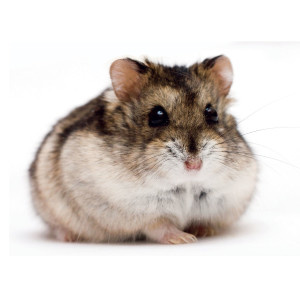Dwarf Hamsters
- Posted on
- By Brenna Stanke

Everything you needed to know about the care of Dwarf Hamsters
There are four species of dwarf hamster: Winter Whites, Russian Campbells, Roborovski, and Chinese. Winter Whites and Russians are two species commonly referred to as Russian Dwarf Hamsters.
Winter whites, also known as the Djungarian Hamster, typically grow to 3-4 inches and the average lifespan is a year and a half, although some have been known to live longer. Whites come in two different colours, normal or agouti, and sapphire, and have two different markings, pearl and marbled. Whites also tend to be the friendliest of all the dwarf hamsters.
Campbells Russian Dwarf Hamsters are somewhat smaller than the whites. They only grow to about 2.5 inches so one must take care when choosing a wire cage and/or playpen. Russians, if not handled early on, can develop (bad) traits such as biting. Most Russian Dwarf Hamsters love to box, no matter how old they are or how handled they are. When purchasing one for a young child, make sure that they have adult supervision as Russians can be quite speedy.
The average lifespan for Chinese Hamsters is 2-4 years and they only grow to 2 to 2.5 inches. Chinese Hamsters are not part of the Dwarf Hamster family but are often confused to be. This is because of their small size and the dark stripe down their back. Chinese Hamsters are not typically recommended as pets for young kids, since they are known to be fast and hard to catch.
Roborovski’s Hamsters grow to be around 2 to 3 inches and their average lifespan is 3-4 years. They are probably the easiest to tell apart from the other subspecies of dwarf hamsters. They only come in one colour, which is agouti, and have one marking/mutation known as husky or white faced. Roborovski’s are not recommended as pets because they are too fast for young kids. When planning to own one expect that you probably won’t be holding or handling them .
Diet
One of the best foods for Hamsters is Oxbow’s Healthy Handfuls-Hamster and Gerbil food. It is very easy for Hamsters to become diabetic (since they’re so teeny) so feeding them sugary seed mixes and sugary treats is a big no. Oxbow’s food has 15.00% protein and the fat content is 4.50% whereas the average seed mix has anywhere from 12.00 to 14.00 % protein and 4.00 to 6.00% fat.
Dwarf Hamsters don’t eat the outside of the seed; they break them open and eat what’s inside. Typical seed mixes are usually sprayed with nutrients, rather than having them baked into the mix. Add this to a less than ideal protein to fat ratio and you get a poor, unbalanced diet. Make sure only to fill your hamster’s food dish halfway. Hamsters are notorious hoarders so it’s best to look around their cage first and see if they have food stashed anywhere. Sometimes they will even hide their pellets in their litter box!
The only hay that hamsters can eat is Oxbow’s Oat Hay and it should be given freely and in unlimited amounts. They eat all of the oat seeds and then use the leftover stems to build their nest and to build up skills like foraging.
Hamsters in general, prefer water bottles over bowls. They will drink out of bowls if that’s what they’re given but I’ve always found that mine enjoy the bottles more.
Treats
Most treats are high in sugar, like the Living World Drops Treats (Literally the first ingredient is sugar), and are fed too much and too often. Treats should make up less than 5% of their diet, which evens out to about 1 treat a day.
Oxbow has a great line of treats, including the Papaya Medley, Strawberry Treats, and Veggie Treats. The Papaya Medley in particular is great because it’s low in sugar and aids in digestive issues. An alternative to Oxbow is Martins, which is also low in sugar and comes in both a banana and apple flavour.
Supplements/Fruits/Veggies
There are supplements available for small animals, however it is not required. One excellent option is “Missing Link Small Animal Formula.” It helps in many ways along with improving their skin and coat. Fruits and Vegetables are great treats and provide the right vitamins and minerals that hamsters need. Treats should make up less than 5% of their diet so they should be given in moderation. Fruit can also be high in sugar, so watch what you feed them.
Bedding
Living World’s Fresh and Comfy or Carefresh are decent bedding brands for hamsters but they are pretty dusty, so only use them if you have a wire cage. High amounts of dust in a closed in space can lead to respiratory infection. One great brand is Daily Scoops (Cat Litter). There is little to no dust and hamsters are unlikely to try to eat it. Keep in mind that there is no real opportunity for them to burrow in it, so you will need to provide something soft as well. Hamster Fluff, fleece, or some sort of hammock or pouch will suffice.
Cages
The Medium Hamster Haven Prevue Hendryx) wire cage is highly recommended. This is usually in stock at Critter Jungle. Black Bear and Syrian Hamsters grow to around 5 to 6 inches so they’ll need quite a bit more of space. Winter Whites and Russians do quite well in wire cages, as long as they are let out everyday and their cage is cleaned regularly. Robo’s and the Chinese Hamsters should be kept in aquarium style cages that are well ventilated. Robo’s need a lot of space to run around (since they’re not very tame) and often excel in aquariums. Chinese Hamsters don’t get to be very big and can easily squeeze themselves out of the wire cages.
Chews
Hamster’s teeth, like all small animals, continuously grow through their entire life. If they aren’t on a food that will trim their teeth or aren’t provided some sort of chew toy, their teeth will become overgrown. Another reason why Oxbow’s Hamster and Gerbil food is so great is its shape. It looks like large cheerios’ and takes a lot of work for the Hamster to eat. This naturally grinds down their teeth. Critter Jungle offers other options such as chewable tunnels (chew-nels) or apple sticks. We also sell mineral blocks but they aren’t very healthy and are not as attractive to Hamsters.
Exercise
A lot of people think that hamsters love exercise balls. While some do enjoy them, the majority of hamsters get stressed out by being in them. It’s best to use “Silent Spinner wheels”, because they don’t have holes on their bottom so Hamsters won’t risk breaking their legs. They also don’t make much noise so humans won’t be woken up at night. Using the second smallest size silent spinner will help to prevent back problems.
Illness
Like every other animal, it’s in their nature to hide any illnesses or weaknesses so that potential predators won’t think to attack them. If they ever get sick or are injured in any way, you probably won’t know about it for a long time. The most common illnesses are: wet tail, respiratory infections, diabetes, constipation, broken limbs, and tumours.
Wet tail is one of the more serious illnesses; it’s extremely contagious and can be fatal if not treated within two days. It’s mainly caused by stress or an unbalanced diet. It will make the hamster dehydrated, hunched over and scruffy looking (their eyes will probably be closed too), and their bum will be soiled and smelly. This is why new owners must let their animals get settled for the first day or two. Otherwise they may become too stressed out by the new environment and new people. Make sure to take your hamster to the vet as soon as you notice any of these symptoms. This is more often seen in Syrian Hamsters than any other.
Respiratory infections are dangerous because the immune system of the hamster is lowered and they are more susceptible to other diseases. Hamsters have been known to get respiratory infections from dusty bedding. This is especially true when it contains baking soda. To treat it, move the hamster to a safer environment for a few days, or remove the dusty material. Then boil some thyme (fresh thyme is preferred and should be done about once a day until cured) and kept it on the outside of the play pen, near where the hamster sleeps, to help clear their sinuses. You may also use a colloidal silver spray bottle, sprayed into their nose about 3-5 times a day. Just make sure you hold the bottle far enough away from them that the impact of it isn’t too strong.
Hamsters will often become diabetic if they are being fed sugary seed diets, too much fruit and veggies while not getting out of the cage enough. You should consider switching to a pellet diet at this point and lowering the amount of food they get. Most vegetables are low in fat and calories. It would be best to supplement their new lowered food intake with red peppers since they’re high in vitamin A and C and are known for increasing the metabolic rate. Carrots are also high in vitamin A, which is an immune system booster, and apples and bananas are high in fibre which is good for balancing their blood sugar.
With constipation in hamsters, it’s best to supplement their diet with canned pumpkin and give them watery veggies and fruits that are high in fibre. Do this in small amounts throughout the week to make sure they are drinking. If they are constipated, make sure you are not putting too much food into their system. The main issue is dehydration not starvation. You can try soaking their dry food in water to make it easier for them to eat. This also helps get water into their system. Placing a bowl of water in addition to their current water bottle or bowl could also encourage them to drink more.
If your ham has broken something, the only thing you can do for them would be to make everything as comfortable as possible. Make sure their food, water, and bed is close by and easy for them to get to. Then, contact your vet and book an appointment as soon as possible. Giving the hamster fresh sprigs of lavender can really help to calm them down if they’ve broken something or if they’re in a stressful environment.
If you think your hamster has a tumour, go to the vet immediately because it will only get worse and more tumours will develop. Odds are you will have to have the tumour surgically removed, unless the vet decides that it’s harmless and just a growth. Tumours are more often seen in Syrians than in any other hamster.
NEVER BATH YOUR HAMSTER IN WATER. That can and probably will make them catch a cold. Instead, buy them a dust bath and dust sand for them to clean themselves in or just let them roll around in the dust of their cage after you’ve removed all of the bedding.)
Written by: Brenna Stanke
Sources and References:
http://www.hamster-club.com/health.asp
http://www.chatelaine.com/health/healthy-recipes-health/five-health-benefits-of-red-peppers/

